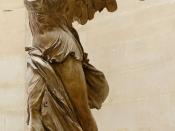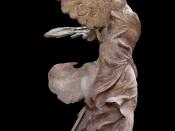There seems to be a classic beauty to all Greek art. In the Hellenistic period is where it truly shined. When I saw the image of Nike of Samothrace I feel in love with the way the statue looked. It had a devine beauty to it. The way the lines of the chiton flowed, the detail on the wings, just gorgeous. The statues, Nike of Samothrace, also known as Winged Victory of Samothrace, and The Dying Warrior, from the west pediment of the temple of Aphaia, are two pieces that compare and contrast in several ways. Their historical importance as symbols, their sculptural mediums, styles and dimensions, and their functions make them historically relevant.
Nike of Samothrace is a marble statue which depicts a graceful, robed female icon. The statue has lost both arms, and her head. In Greek mythology, Nike was a goddess who personified triumph and victory.
She was capable of running and flying at great speeds. Nike was the daughter of Pallas and Styx and the sister of Cratos, Bia, and Zelus. Nike and her siblings were all companions of Zeus .
This particular statue is probably the most famous from the Hellenistic period in the Greek culture. The Hellenistic period is reckoned from the death of Alexander in 323 B.C.E. and lasted nearly three centuries until 31 B.C.E. The Greek cultural centers of the Hellenistic period were the court cities of the Greek kings: Antioch in Syria, Alexandria in Egypt, Pergamon in Asia Minor, and others. Hellenistic Kings became enormously rich on the soils of the east, priding themselves on libraries, art collections, scientific enterprises, etc . Although a large number of statues were created for the kings in this period, Nike of Samothrace was set up in the Sanctuary of the great gods on...


